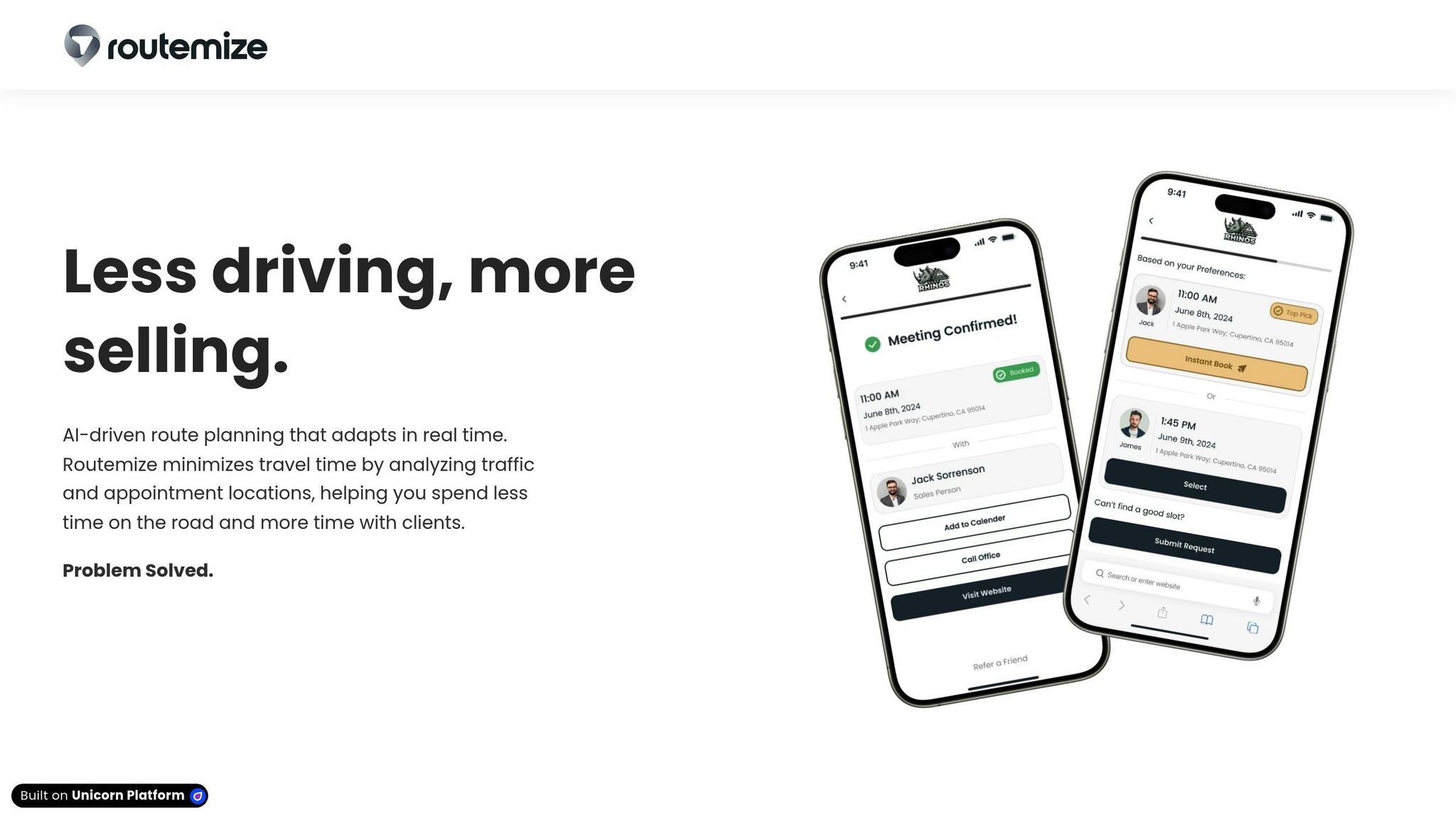Load balancing in route optimization ensures delivery operations run efficiently by evenly distributing workloads across fleets. This approach reduces costs, improves delivery times, and enhances resource utilization. Here's what you need to know:
-
Key Benefits:
- Lower fuel consumption and vehicle wear.
- Faster, more reliable delivery schedules.
- Increased fleet productivity and reduced operational costs.
-
How It Works:
- Algorithms consider factors like traffic, vehicle capacity, and delivery locations.
- Real-time updates dynamically adjust routes to avoid delays.
- Tools like Routemize use AI to optimize workloads and adapt to changing conditions.
-
Steps to Implement:
- Evaluate current routes for inefficiencies.
- Choose route planning software with real-time traffic analysis.
- Track metrics like fuel usage and delivery times to refine operations.
- Address common challenges like outdated data and sudden disruptions.
Main Benefits of Load Balanced Routes
Better Resource Distribution
Load balancing ensures delivery operations are spread evenly, avoiding overworking some drivers while others are underutilized. This balance leads to smoother operations and better results.
Take Hardie's Fresh Foods in Texas as an example. After adopting load-balanced routes, Logistics Manager Arley Garner shared: "[Route optimization resulted in] approximately two additional jobs per driver per day, or more than 330 extra deliveries per day. It's exceptional." This shows how proper planning can transform efficiency and boost productivity.
Faster Delivery Times
Load balancing directly improves delivery speed by addressing key factors:
| Factor | Impact on Delivery Speed |
|---|---|
| Geographic Distribution | Drivers are assigned deliveries closest to their location. |
| Workload Management | Prevents system overload by managing requests effectively. |
| Real-time Adaptation | Adjusts routes dynamically based on traffic and conditions. |
For example, a health-tech company that used NextBillion.ai's route optimization saw impressive results. Their optimized sample collection schedules cut travel times and slashed operational costs by 25%.
These time savings don’t just improve service - they also reduce expenses and increase overall capacity.
Lower Costs and Higher Output
Load-balanced routes can significantly cut costs. With driver wages and fuel costs making up around 59.8% of total operational expenses per mile, optimizing routes becomes a no-brainer.
Telgian, a fire protection and security services provider, is a great case study. After implementing load-balanced route optimization, they achieved:
- 256 fewer hours spent on monthly planning
- 19% year-over-year growth
- 70% increase in capacity while reducing dispatch staff
"Load balancing in the context of vehicle routing problems is a way to achieve a more evenly distribution of jobs or activities over your drivers' routes. The most obvious ones are resource utilization and fairness."
Modern route optimization tools can cut mileage by up to 20% and double order capacity - all without adding more vehicles. These tools make it easier to save money while scaling operations effectively.
Load Balancing Algorithm Basics
Main Algorithm Components
Efficient load balancing in route optimization relies on several key components:
| Component | Function | Impact |
|---|---|---|
| Vehicle Capacity | Monitors capacity limits | Avoids overloads and ensures efficient use of vehicles |
| Time Windows | Tracks delivery schedules and constraints | Keeps deliveries on time within promised windows |
| Geographic Distribution | Evaluates delivery locations and distances | Improves route efficiency and minimizes unnecessary travel |
| Resource Availability | Keeps tabs on driver schedules and vehicle status | Ensures even workload distribution across the fleet |
These components work together to streamline operations. Algorithms can operate in two modes: static, which rely on preset rules for task assignments, or dynamic, which adapt based on real-time data.
Real-Time Route Updates
Modern systems for load balancing use real-time data to adjust routing on the fly. This is crucial because traffic congestion alone can have a massive economic impact. With real-time updates, vehicles can be rerouted instantly to avoid delays, helping to stick to schedules and save money.
Dynamic routing algorithms analyze a variety of live inputs, such as traffic conditions, road closures, accidents, weather, driver locations, and new delivery requests. AI-powered platforms are a prime example of how this technology works in action.
Routemize: AI Load Balancing

Routemize takes dynamic routing to the next level. By analyzing traffic patterns and delivery locations in real time, it helps businesses adjust quickly to changing conditions.
Unlike static methods, Routemize uses machine learning to automatically update routes based on live data. It focuses on minimizing travel time, optimizing appointment schedules, and evenly distributing workloads. This flexible system keeps delivery operations running smoothly throughout the day, helping businesses meet service expectations while managing costs.
4 Steps to Add Load Balancing
1. Evaluate Current Routes
Start by tracking these key metrics to pinpoint inefficiencies:
| Metric | What to Measure | Why It Matters |
|---|---|---|
| Delivery Time | Average completion time per route | Pinpoints delays and bottlenecks |
| Distance | Miles covered per vehicle | Identifies areas to cut unnecessary mileage |
| Fuel Usage | Consumption patterns by route | Highlights routes needing better fuel efficiency |
| Driver Input | Feedback from drivers | Offers practical insights from the field |
| Customer Experience | Delivery satisfaction rates | Shows how routes impact service quality |
These metrics help uncover areas where routes can be improved for better efficiency and reduced costs.
2. Pick Route Planning Software
Choose software that simplifies route planning with tools like traffic analysis, automated optimization, and detailed analytics. Here are some popular options:
- Maptitude: Highly rated (4.7/5 on G2 from 138 reviews), great for territory management and integration with business tools.
- Onfleet: Ideal for last-mile delivery, offering predictive ETAs.
- Samsara: Combines AI-driven optimization with real-time tracking.
- Verizon Connect: Known for its strong focus on fuel tracking.
When selecting software, look for features like real-time traffic updates, automated optimization, load distribution algorithms, system integration, and detailed analytics. Once implemented, regularly monitor the software's performance and make adjustments as needed.
3. Track and Improve Results
Use data to refine routes and cut costs. Transportation expenses can make up as much as 50.3% of logistics spending, so tracking improvements is crucial.
- Gather route data, including location, time windows, and vehicle availability.
- Use optimization tools to minimize human error.
- Check if drivers are sticking to planned routes.
- Coordinate with customers to manage vehicle capacity efficiently.
"Route data enables you to plan routes based on location data, geolocation data, vehicle weight, depot and driver service schedules, and route information." - eLogii
sbb-itb-7020db0
Common Load Balancing Problems
Getting Good Data
The quality of your data plays a major role in how well route optimization works. Here are some typical challenges and ways to address them:
| Challenge | Impact | Solution |
|---|---|---|
| Outdated Information | Leads to inefficient routes and missed deliveries | Use real-time data collection tools |
| System Integration | Scattered data across multiple platforms | Integrate CRM and inventory systems |
| Connectivity Issues | Causes delays in updating data from remote areas | Implement offline solutions with syncing capabilities |
| Data Security | Risks exposing sensitive information | Apply strong encryption and controlled access measures |
Reliable real-time data and solid IT infrastructure are essential for smooth operations. Plus, being ready to adjust quickly when conditions shift is just as important.
Handling Sudden Changes
Unexpected disruptions require immediate action. By leveraging dynamic route optimization and live tracking, you can quickly adjust routes to handle surprises like traffic jams or weather issues. This ensures your routes stay efficient, no matter what.
"Ensuring transportation operations are making the most efficient use of vehicles, fuel, and drivers is a high priority." - William Salter, CEO and president of Paragon Software Systems
With these tools in place, dispatchers can make smarter decisions, rerouting vehicles to avoid obstacles while keeping operations on track.
Managing Costs vs. Speed
Once data quality and sudden changes are addressed, the next challenge is finding the right balance between cost and speed. Here are some practical ways to achieve this:
- Minimize Empty Miles: Plan backhauls into your schedules to make better use of assets and cut fuel expenses.
- Set Specific Delivery Windows: Precise scheduling reduces wasted time and failed deliveries.
- Monitor Performance: Keep an eye on metrics like fuel use, delivery success rates, and route accuracy. Compare planned routes with actual ones to spot areas for improvement.
Fleet Management Tutorial: Routing Optimization & Balance
Conclusion
Load balancing plays a crucial role in optimizing routes. Studies show that U.S. trucks run with 20–35% empty miles, and loaded vehicles operate at just 57% of their capacity. This highlights the pressing need for better load balancing strategies.
Key Takeaways
Here are some of the main points to consider when it comes to load balancing:
| Area | Impact | Key Consideration |
|---|---|---|
| Resource Utilization | Cuts down on empty miles and improves vehicle capacity | Leverage TMS and route optimization tools |
| Data Management | Supports real-time route changes | Use predictive analytics to spot issues early |
| Cost Efficiency | Streamlines delivery processes | Consolidate shipments along shared routes |
| Customer Service | Improves delivery times and reliability | Adjust operations based on customer needs |
"As the logistics industry evolves, load balancing will remain crucial for seamless, data-driven, and customer-centric last-mile logistics solutions." - RTInsights
Modern load balancing has come a long way, with advanced software now managing complex requests. Real-time route updates and dynamic allocation are key features driving this progress. The future lies in systems that can quickly adjust to changing conditions, turning static routing into a dynamic, performance-focused process.
To implement load balancing effectively, businesses need to prioritize high-quality data, seamless system integration, and ongoing monitoring. By doing so, they can boost efficiency, reduce costs, and shift from reactive operations to proactive, optimized logistics. These strategies show how dynamic, data-driven routing can reshape the way organizations handle their logistics.


